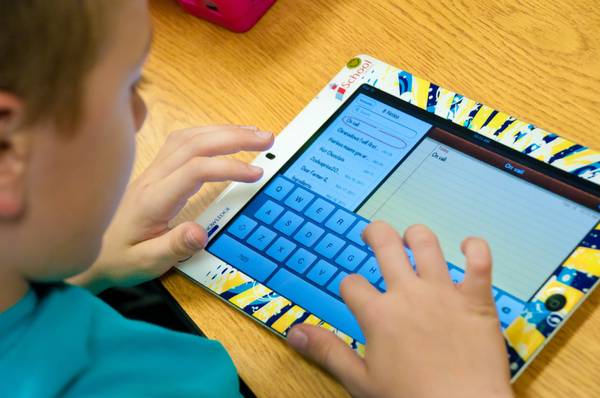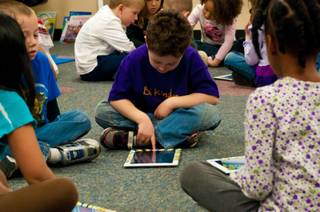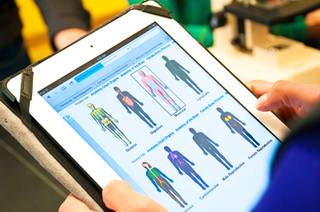Sun coverage
- At Las Vegas charter school, iPads pave students’ path to learning (02-21-2012)
- Schools seeing improvement in math scores as students play video game (02-08-2012)
- New iPad app for digital textbooks excites Clark County schools (01-19-2012)
- Clark County’s charter schools experiment with technology (07-13-2011)
Even as the cash-strapped Clark County School District faces a $64 million budget deficit next year, officials are contemplating spending up to $65.1 million over the next several years to expand technology offerings to students and teachers.
That’s on top of about $84 million the district spends each year to maintain its current technology infrastructure: computer servers, telephones, computers, Internet and networks.
During Wednesday’s School Board meeting (which was dominated by budget talks), Jhone Ebert, the district’s chief technology officer, presented a $149.1 million budget proposal that, if approved, would help propel Clark County toward an increasingly digital curriculum over the next several years.
Students can expect more tablets and laptops in classrooms, as well as software and electronic textbooks. It’s all part of the School District’s efforts to raise student achievement, Ebert said.
Over the past decade, technology upgrades and maintenance were paid in large part from the 1998 school construction bond program. Bonds allowed the district to build more than 100 new schools to address Las Vegas’ rapid population growth and helped pay for new computers, smartboards and audio equipment in classrooms as well as a districtwide Wi-Fi network.
As the bond program comes to a close, however, the district is considering a new, $5.3 billion school bond program to help modernize its buildings over the next decade. The proposal could go to voters in November.
If approved, most of the money from bond sales would go toward upgrades at dilapidated schools. However, about $1 billion may be used to purchase new technology and equipment. (If the program isn’t approved, the district has the option to absorb technology costs in its general operating fund.)
Ebert’s $116.1 million budget proposal outlined how the district might start spending the money if a new program is approved.
•••
A little less than half of the technology budget will still be allocated toward annual technology maintenance. The rest will go toward a number of new digital initiatives.
The School District currently spends about $84 million a year on its existing technology infrastructure. About $33 million comes out of the district’s general fund; the other $51 million is from bond proceeds, Ebert said.
The $33 million represents about 1.65 percent of its $2 billion operating expenses, Ebert said. Most government entities spend about 2.7 percent of their operating budget on technology, she added.
Other major school districts spend more of their budgets on information technology, Ebert continued. The Los Angeles Unified School District, the second largest in the nation, spends more than 3 percent of its $7.3 billion on IT, she said.
Still, the Clark County School District spends more than $20 million each year on computers, printers, projectors, smartboards and document cameras used in classrooms.
It also has more than 33,000 telephones and more than 12,200 Wi-Fi access points. More than 330 schools have their own servers, and the district is considering consolidating all of its server space into one main hub.
Further, there are a number of employee and student data systems to administer payroll, compute grades, compile attendance records and issue transcripts.
Many of these data systems are aging and will need a complete overhaul, Ebert said. For example, the student information system is no longer supported by its vendor, which means a catastrophic failure could result in student data inaccuracies.
“These systems are past the end of their shelf life. It’s not a matter of if but when it’s going to fail,” Ebert said. “We need a more efficient tool so that teachers can spend more time with students in the classroom.”
Austin, Texas-based consultant Greg Gibson recommended in September that the district replace its outdated human resources and student information systems at a cost of $33 million over five years.
Ebert compared the technology infrastructure supporting students, teachers and administrators to an iceberg, the bulk of which is hidden underneath the water. When students and parents see classroom computers and digital projectors, they are only seeing the tip of the technology infrastructure needed for the district to function, Ebert said.
“There’s all this technology below to help support the 21st-century student,” she said.
•••
Amid the recession and despite some initial controversy, the School District has begun loosening its purse strings for technology.
It began piloting electronic textbook initiatives at several schools this year, despite its controversial decision two years ago to purchase $1 million worth of iPads for administrators.
In the fall, it launched one of the largest iPad textbook programs in the country at a cost of about $800,000. Some magnet, charter and career technical academies also have adopted iPads and other digital technology in the classroom.
The district plans to expand these pilot programs gradually, Ebert said. A tablet and netbook program is expected to start this fall at five middle schools at a cost of about $1 million per school.
Officials hope to have about a third of the district’s 309,000-student population studying in online and “blended” online and traditional classrooms by 2015. To get there, they hope to have the money — about $300 per student per semester — to harness online curricula and digital tools for learning, Ebert said.
This isn’t so much a funding increase but a funding reallocation, she stressed. Digital devices — like an iPad — will replace traditional paper textbooks and graphing calculators, she said.
The district is unlikely to raise enough capital to give each student a netbook or iPad, Ebert said. Instead, the district is looking at beefing up its technology infrastructure – wireless networks and server systems – to prepare for a future where students bring their own laptop to school and standardized tests are taken online.
“Our job as educators is to prepare students for the modern workforce,” Ebert said. “Construction workers, architects, everyone is using technology to receive, consume and digest information.”
•••
Most School Board members said Wednesday they felt the School District must make an investment toward creating classrooms that are better suited for students in the 21st century.
Board member Deanna Wright said it would be foolish not to embrace technology because students are already digital learners.
“It’s frustrating to me that people want to reduce education to pencils and papers in a red schoolhouse like in Laura Ingalls Wilder,” she said, referencing “Little House on the Prairie.” “The world is expecting more from our kids.”
School Board member Carolyn Edwards questioned the costs of constantly upgrading technology and accessibility to all students but also said she supported the digitization of the classroom.
“This is so critical if we want to be No. 1 in the country,” Edwards said.
Adopting a technology-minded education is crucial to compete in the global marketplace, School Board President Linda Young added.
“We don’t have a choice. We’re in an international competition,” she said. “We have to move forward.”






Join the Discussion:
Check this out for a full explanation of our conversion to the LiveFyre commenting system and instructions on how to sign up for an account.
Full comments policy